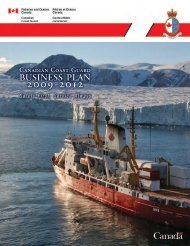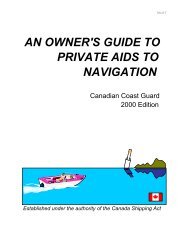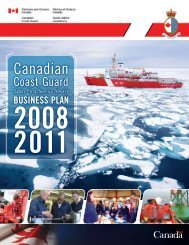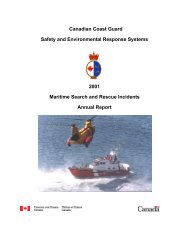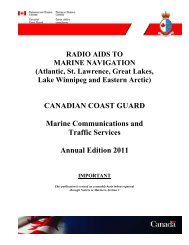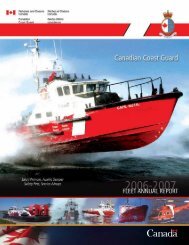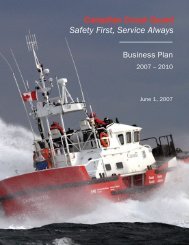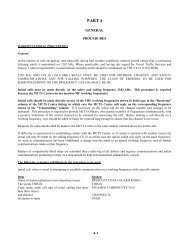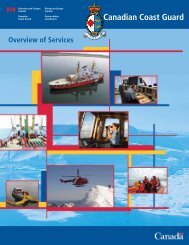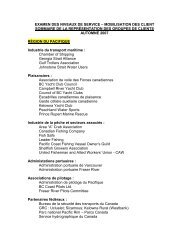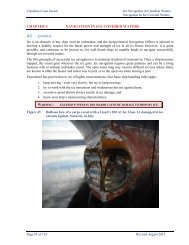RADIO AIDS TO MARINE NAVIGATION - Canadian Coast Guard
RADIO AIDS TO MARINE NAVIGATION - Canadian Coast Guard
RADIO AIDS TO MARINE NAVIGATION - Canadian Coast Guard
Create successful ePaper yourself
Turn your PDF publications into a flip-book with our unique Google optimized e-Paper software.
ATHABASCA – MACKENZIE WATERSHED AREA: DISTRESS, URGENCY, SAFETY COMMUNICATIONS –<br />
USE OF 5803 kHz<br />
The frequency of 5803 kHz is the area distress and calling frequency for the Athabasca – Mackenzie inland waterways.<br />
This frequency should be carried on all commercial vessels and will be monitored at all times when the vessel is in active<br />
operation on the waterways.<br />
This frequency will not be used for any type of communication other than distress, urgency and safety communications and<br />
for the purpose of establishing initial radio contact with another vessel or shore station. After initial contact is made, for<br />
other than distress or emergency communication, the vessel and/or shore station involved will immediately transfer to an<br />
established working frequency.<br />
For the provision of relay or assistance in communication to a land station or other vessel, the <strong>Canadian</strong> <strong>Coast</strong> <strong>Guard</strong> will<br />
provide, during the shipping season, 24 hour receive and transmit facilities on 5803 kHz from MCTS Inuvik/VFA.<br />
<strong>AIDS</strong> <strong>TO</strong> <strong>NAVIGATION</strong><br />
Positions<br />
All positions expressed in latitude and longitude of the radio aids to navigation listed in this publication are approximate<br />
and are taken from the largest scale <strong>Canadian</strong> Hydrographic Service charts, where available, or British Admiralty charts of<br />
the vicinity. Mariners should bear in mind when plotting the position of any given aid that it is preferable to use a chart<br />
with the aid already located on it than to plot it from a position given in latitude and longitude.<br />
Reporting Abnormal Operation of Radio Aids<br />
A marine radio aid observed to be operating abnormally should be reported, as soon as possible to an MCTS Centre.<br />
Reports shall be as complete as possible, giving full details including time, date, the position from which the observation<br />
was made, and details and description of conditions, such as weather and reception, prevailing at the time of the<br />
observation.<br />
It is also requested that ships report abnormal MCTS Centre operation, such as poor quality of marine telephone calls,<br />
unreadability of broadcasts, failure to answer calls, etc.<br />
To ensure prompt corrective action, such reports must include the date, time and position of ship when the observation was<br />
made, together with details of prevailing weather and reception conditions.<br />
Radio Beacons<br />
Marine radio beacons generally operate in the 285 - 325 kHz. Radio beacon service enables ships fitted with direction<br />
finding equipment to take a bearing or to take several consecutive bearings which will provide a fix. See Part 2 for details<br />
on individual listings<br />
Radar Beacons (RACONS)<br />
Radar beacons (Racons) may be established at lighthouses, on buoys or at other specific charted locations ashore or afloat<br />
to enhance identification and detection range of these features by radar.<br />
Some Racons operate only in the X band 9320-9500 MHz, whilst others are dual band X/S, X band plus S band of<br />
2920-3100 MHz. It should also be noted that the slow sweep (SS) type of Racon will give a response every<br />
72-120 seconds, whilst the frequency agile Racon (FAR) will respond more frequently.<br />
The Racon signal appears on the radar display as a line commencing at the approximate range of the Racon and extending<br />
outwards along its line of bearing from the ship toward the limit of the display. The signal displayed may be a solid line or<br />
it may be broken into a code consisting of a series of dots and dashes as shown in relevant publications.<br />
4-8



